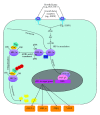Emerging glycolysis targeting and drug discovery from chinese medicine in cancer therapy
- PMID: 22844340
- PMCID: PMC3403522
- DOI: 10.1155/2012/873175
Emerging glycolysis targeting and drug discovery from chinese medicine in cancer therapy
Abstract
Molecular-targeted therapy has been developed for cancer chemoprevention and treatment. Cancer cells have different metabolic properties from normal cells. Normal cells mostly rely upon the process of mitochondrial oxidative phosphorylation to produce energy whereas cancer cells have developed an altered metabolism that allows them to sustain higher proliferation rates. Cancer cells could predominantly produce energy by glycolysis even in the presence of oxygen. This alternative metabolic characteristic is known as the "Warburg Effect." Although the exact mechanisms underlying the Warburg effect are unclear, recent progress indicates that glycolytic pathway of cancer cells could be a critical target for drug discovery. With a long history in cancer treatment, traditional Chinese medicine (TCM) is recognized as a valuable source for seeking bioactive anticancer compounds. A great progress has been made to identify active compounds from herbal medicine targeting on glycolysis for cancer treatment. Herein, we provide an overall picture of the current understanding of the molecular targets in the cancer glycolytic pathway and reviewed active compounds from Chinese herbal medicine with the potentials to inhibit the metabolic targets for cancer treatment. Combination of TCM with conventional therapies will provide an attractive strategy for improving clinical outcome in cancer treatment.
Figures




Similar articles
-
Targeting FASN in Breast Cancer and the Discovery of Promising Inhibitors from Natural Products Derived from Traditional Chinese Medicine.Evid Based Complement Alternat Med. 2014;2014:232946. doi: 10.1155/2014/232946. Epub 2014 Mar 13. Evid Based Complement Alternat Med. 2014. PMID: 24778702 Free PMC article. Review.
-
Discovery of potential asthma targets based on the clinical efficacy of Traditional Chinese Medicine formulas.J Ethnopharmacol. 2020 Apr 24;252:112635. doi: 10.1016/j.jep.2020.112635. Epub 2020 Jan 28. J Ethnopharmacol. 2020. PMID: 32004629
-
Anticancer strategies based on the metabolic profile of tumor cells: therapeutic targeting of the Warburg effect.Acta Pharmacol Sin. 2016 Aug;37(8):1013-9. doi: 10.1038/aps.2016.47. Epub 2016 Jul 4. Acta Pharmacol Sin. 2016. PMID: 27374491 Free PMC article. Review.
-
The dichotomous role of the glycolytic metabolism pathway in cancer metastasis: Interplay with the complex tumor microenvironment and novel therapeutic strategies.Semin Cancer Biol. 2020 Feb;60:238-248. doi: 10.1016/j.semcancer.2019.08.025. Epub 2019 Aug 21. Semin Cancer Biol. 2020. PMID: 31445217 Review.
-
Metabolic Factors and Adult Neurogenesis: Impacts of Chinese Herbal Medicine on Brain Repair in Neurological Diseases.Int Rev Neurobiol. 2017;135:117-147. doi: 10.1016/bs.irn.2017.02.007. Epub 2017 Apr 7. Int Rev Neurobiol. 2017. PMID: 28807156
Cited by
-
Identification of Potential Anticancer Protein Targets in Cytotoxicity Mediated by Tropical Medicinal Fern Extracts.Pharmacogn Mag. 2018 Apr-Jun;14(54):227-230. doi: 10.4103/pm.pm_282_17. Epub 2018 Apr 10. Pharmacogn Mag. 2018. PMID: 29720836 Free PMC article.
-
Time course changes of anti- and pro-apoptotic proteins in apigenin-induced genotoxicity.Chin Med. 2013 May 4;8(1):9. doi: 10.1186/1749-8546-8-9. Chin Med. 2013. PMID: 23642018 Free PMC article.
-
Bioactivity-guided identification and cell signaling technology to delineate the lactate dehydrogenase A inhibition effects of Spatholobus suberectus on breast cancer.PLoS One. 2013;8(2):e56631. doi: 10.1371/journal.pone.0056631. Epub 2013 Feb 14. PLoS One. 2013. PMID: 23457597 Free PMC article.
-
Small molecule inhibitors for cancer metabolism: promising prospects to be explored.J Cancer Res Clin Oncol. 2023 Aug;149(10):8051-8076. doi: 10.1007/s00432-022-04501-4. Epub 2023 Mar 31. J Cancer Res Clin Oncol. 2023. PMID: 37002510 Free PMC article. Review.
-
Targeting Energy Metabolism in Cancer Treatment.Int J Mol Sci. 2022 May 16;23(10):5572. doi: 10.3390/ijms23105572. Int J Mol Sci. 2022. PMID: 35628385 Free PMC article. Review.
References
-
- Jemal A, Siegel R, Xu J, Ward E. Cancer statistics, 2010. CA Cancer Journal for Clinicians. 2010;60(5):277–300. - PubMed
-
- Ocana A, Pandiella A, Siu LL, Tannock IF. Preclinical development of molecular-targeted agents for cancer. Nature Reviews Clinical Oncology. 2011;8(4):200–209. - PubMed
-
- Prat A, Baselga J. The role of hormonal therapy in the management of hormonal-receptor-positive breast cancer with co-expression of HER2. Nature Clinical Practice Oncology. 2008;5(9):531–542. - PubMed
-
- Ernst E. Complementary and alternative medicine (CAM) and cancer: the kind face of complementary medicine. International Journal of Surgery. 2009;7(6):499–500. - PubMed
LinkOut - more resources
Full Text Sources

